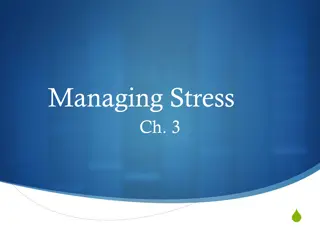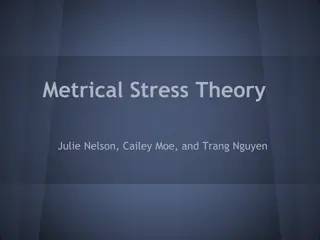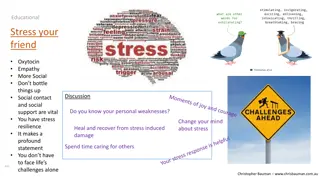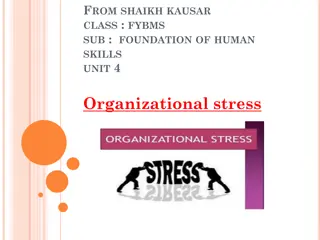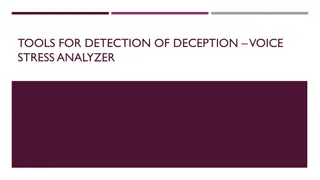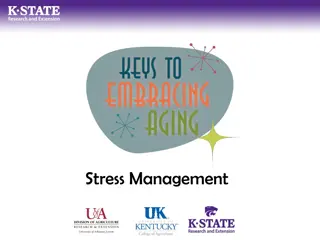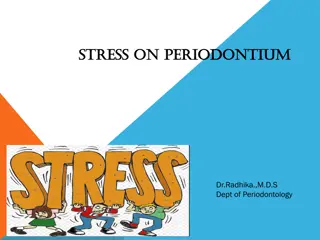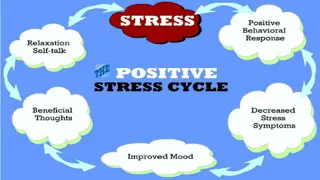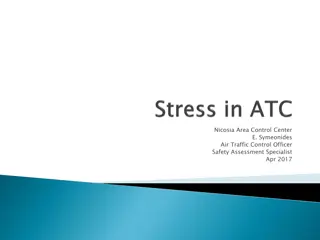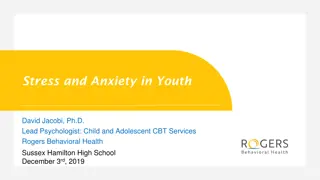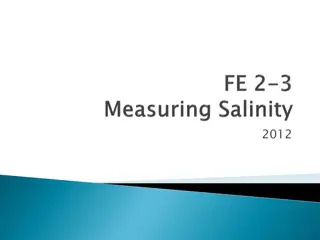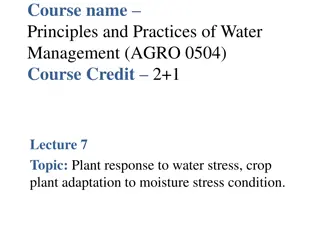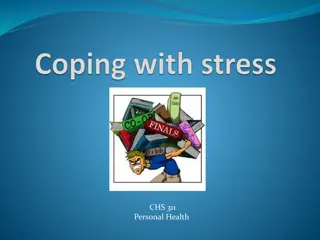Understanding Stress Management
Stress is a psychological and physical state resulting from inadequate resources to cope with pressures, affecting individuals and organizations. Explore the concept of stress, its definition, fight or flight response, distress versus eustress, and the problem of stress in various aspects of life.
Download Presentation

Please find below an Image/Link to download the presentation.
The content on the website is provided AS IS for your information and personal use only. It may not be sold, licensed, or shared on other websites without obtaining consent from the author. Download presentation by click this link. If you encounter any issues during the download, it is possible that the publisher has removed the file from their server.
E N D
Presentation Transcript
STRESS MANAGEMENT
Outline INTRODUCTION THE CONCEPT OF STRESS WHAT IS STRESS? PROBLEM OF STRESS SIGNS OF STRESS SUGGESTIONS FOR REDUCING STRESS WORKPLACE FACTORS CAUSING STRESS MANAGEMENT OF STRESS CONCLUSION
Introduction It is the psychological and physical state that results when the resources of the individual are not sufficient to cope with the demands and pressures of the situation. Thus, stress is more likely in some situations than others and in some individuals than others. Stress can undermine the achievement of goals, both for individuals and for organizations
The Concept of STRESS Stress has been defined in different ways over the years. Originally, it was conceived of as pressure from the environment, then as strain within the person. The generally accepted definition today is one of interaction between the situation and the individual
What is Stress? Stress can be defined as our mental, physical, emotional, and behavioral reactions to any perceived demands or threats.
The Fight or Flight Response When situations seem threatening to us, our bodies react quickly to supply protection by preparing to take action. This physiological reaction is known as the "fight or flight" response. The physiological response to a stressor is known as reactivity Physiological responses can accumulate and result in long-term wear on the body
Not All Stress is Bad Distress is a continuous experience of feeling overwhelmed, oppressed, and behind in our responsibilities. It is the all encompassing sense of being imposed upon by difficulties with no light at the end of the tunnel. Examples of distress include financial difficulties, conflicts in relationships, excessive obligations, managing a chronic illness, or experiencing a trauma. Eustress is the other form of stress that is positive and beneficial. We may feel challenged, but the sources of the stress are opportunities that are meaningful to us. Eustress helps provide us with energy and motivation to meet our responsibilities and achieve our goals. Examples of eustress include graduating from college, getting married, receiving a promotion, or changing jobs.
What is Stressful to You? Work Classes Studying Relationship with partner Relationship with family Relationship with friends Trauma Change in residence Change in amount of social activities Roommate Childcare Finances Appearance Legal matters Mental health Law violation Spiritual/Religious issues Major/Career decisions Attitudes/thoughts Physical Health Not fitting in Getting married Change to a new school Change in eating habits Buying a house Change in amount of recreation Death of friend/family member
Stress Response: Example A good example of a stressful situation for many people is taking a test. If you find testing to be stressful, you might notice certain physical, behavioral, mental, and emotional responses. Physical Response? Behavioral Response? Mental Response? Emotional Response?
Why Do We "Stress Out"? For two major reasons: We perceive a situation as dangerous, difficult, or painful. We don't believe we have the resources to cope.
Stress Warning Signals What are your "red flags," or warning signs, that stress is creeping into your life? If we keep pushing ourselves, eventually something inside of use will send "red flags," or warning signs that stress is becoming a problem.
Signs of stress Signs of stress can be seen in people s behaviour, especially in changes in behaviour. Acute responses to stress may be in the areas of feelings (for example, anxiety, depression, irritability, fatigue), behaviour (for example, being withdrawn, aggressive, tearful, unmotivated), thinking (for example, difficulties of concentration and problem solving) or physical symptoms (for example, palpitations, nausea, headaches).
Signs of stress If stress persists, there are changes in neuroendocrine, cardiovascular, autonomic and immunological functioning, leading to mental and physical ill health (for example anxiety, depression, heart disease)
Suggestions for Reducing Stress 1. Find a support system. Find someone to talk to about your feelings and experiences.
Suggestions for Reducing Stress 2. Change your attitude. Find other ways to think about stressful situations. "Life is 10% what happens to us, and 90% how we react to it."
Suggestions for Reducing Stress 3. Be realistic. Set practical goals for dealing with situations and solving problems. Develop realistic expectations of yourself and others.
Suggestions for Reducing Stress 4. Get organized and take charge. Being unorganized or engaging in poor planning often leads to frustration or crisis situations, which most always leads to feeling stressed. Plan your time, make a schedule, establish your priorities.
Suggestions for Reducing Stress 5. Take breaks, give yourself "me time." Learn that taking time to yourself for rejuvenation and relaxation is just as important as giving time to other activities. At minimum, take short breaks during your busy day.
Suggestions for Reducing Stress 6. Take good care of yourself. Eat properly, get regular rest, keep a routine. Allow yourself to do something you enjoy each day. Paradoxically, the time we need to take care of ourselves the most, when we are stressed, is the time we do it the least.
Suggestions for Reducing Stress 7. Learn to say "no." Learn to pick and choose which things you will say "yes" to and which things you will not. Protect yourself by not allowing yourself to take on every request or opportunity that comes your way.
Suggestions for Reducing Stress 8. Get regular exercise. Exercising regularly can help relieve some symptoms of depression and stress, and help us to maintain our health.
Suggestions for Reducing Stress 9. Get a hobby, do something different. For a balanced lifestyle, play is as important as work.
Suggestions for Reducing Stress 10. Slow down. Know your limits and cut down on the number of things you try to do each day, particularly if you do not have enough time for them or for yourself. Be realistic about what you can accomplish effectively each day. Monitor your pace. Rushing through things can lead to mistakes or poor performance. Take the time you need to do a good job. Poorly done tasks can lead to added stress.
Suggestions for Reducing Stress 11. Laugh, use humor. Do something fun and enjoyable such as seeing a funny movie, laughing with friends, reading a humorous book, or going to a comedy show.
Suggestions for Reducing Stress 12. Learn to relax. Develop a regular relaxation routine. Try yoga, meditation, or some simple quiet time.
Relaxation Exercises Many different kinds, but some are: Deep Breathing Visualization: Visualization is a nice way of giving our minds and bodies a "mini vacation. Muscle Relaxation
WORKPLACE FACTORS CAUSING STRESS The workplace is an important source of both demands and pressures causing stress, and structural and social resources to counteract stress. The workplace factors that have been found to be associated with stress and health risks can be categorised as those to do with the content of work and those to do with the social and organisational context of work.
WORKPLACE FACTORS CAUSING STRESS Those that are intrinsic to the job include long hours, work overload, time pressure, difficult or complex tasks, lack of breaks, lack of variety, and poor physical work conditions (for example, space, temperature, light).
Situations that are likely to cause stress are those that are unpredictable or uncontrollable, uncertain, ambiguous or unfamiliar, or involving conflict, loss or performance expectations. Stress may be caused by time limited events, such as the pressures of examinations or work deadlines, or by ongoing situations, such as family demands, job insecurity, or long commuting journeys.
Resources that help meet the pressures and demands faced at work include personal characteristics such as coping skills (for example, problem solving, assertiveness, time management) and the work situation such as a good working environment and social support. These resources can be increased by investment in work infrastructure, training, good management and employment practices, and the way that work is organized.
INDIVIDUAL DIFFERENCES Individuals differ in their risk of experiencing stress and in their vulnerability to the adverse effects of stress. Individuals are more likely to experience stress if they lack material resources (for example, financial security) and psychological resources (for example, coping skills, self esteem), and are more likely to be harmed by this stress if they tend to react emotionally to situations and are highly competitive and pressured (type A behaviour).
INDIVIDUAL DIFFERENCES A successful strategy for preventing stress within the workplace will ensure that the job fits the person, rather than trying to make people fit jobs that they are not well suited to.
INTERACTIONS BETWEEN WORK AND HOME STRESS Increasingly, the demands on the individual in the workplace reach out into the homes and social lives of employees. Long, uncertain or unsocial hours, working away from home, taking work home, high levels of responsibility, job insecurity, and job relocation all may adversely affect family responsibilities and leisure activities.
INTERACTIONS BETWEEN WORK AND HOME STRESS This is likely to undermine a good and relaxing quality of life outside work, which is an important buffer against the stress caused by work. In addition, domestic pressures such as childcare responsibilities, financial worries, bereavement, and housing problems may affect a person s robustness at work. Thus, a vicious cycle is set up in which the stress caused in either area of one s life, work or home, spills over and makes coping with the other more difficult.
INTERACTIONS BETWEEN WORK AND HOME STRESS Women are especially likely to experience these sources of stress, since they still carry more of the burden of childcare and domestic responsibilities than men. In addition, women are concentrated in lower paid, lower status jobs, may often work shifts in order to accommodate domestic responsibilities, and may suffer discrimination and harassment
MANAGEMENT OF STRESS Historically, the typical response from employers to stress at work has been to blame the victim of stress, rather than its cause. Increasingly, it is being recognized that employers have a duty, in many cases in law, to ensure that employees do not become ill. It is also in their long term economic interests to prevent stress, as stress is likely to lead to high staff turnover, an increase in sickness absence and early retirement, increased stress in those staff still at work, reduced work performance and increased rate of accidents, and reduced client satisfaction.
Empirical review A systematic review of the evidence for work factors associated with psychological ill health and associated absenteeism (Michie and Williams 2001, unpublished data) found the key factors to be: long hours worked, work overload and pressure the effects of these on personal lives lack of control over work and lack of participation in decision making poor social support unclear management and work role and poor management style.
INDIVIDUAL STRESS MANAGEMENT Most interventions to reduce the risk to health associated with stress in the workplace involve both individual and organizational approaches. Individual approaches include training and one-to- one psychology services clinical, occupational, health or counselling. They should aim to change individual skills and resources and help the individual change their situation.
INDIVIDUAL STRESS MANAGEMENT However, there are many sources of stress that the individual is likely to perceive as outside his or her power to change, such as the structure, management style or culture of the organisation.
INDIVIDUAL STRESS MANAGEMENT It is important to note that stress management approaches that concentrate on changing the individual without changing the sources of stress are of limited effectiveness, and may be counterproductive by masking these sources. \ For example, breathing deeply and thinking positively about a situation causing stress may make for a temporary feeling of well being, but will allow a damaging situation to continue, causing persistent stress and, probably, stress to others. The primary aim of the individual approach should be to develop people s skills and confidence to change their situation, not to help them adapt to and accept a stressful situation.
ORGANISATIONAL STRESS MANAGEMENT The prevention and management of workplace stress requires organisational level interventions, because it is the organization that creates the stress. An approach that is limited to helping those already experiencing stress is analogous to administering sticking plaster on wounds, rather than dealing with the causes of the damage.
ORGANISATIONAL STRESS MANAGEMENT An alternative analogy is trying to run up an escalator that s going down! Organisational interventions can be of many types, ranging from structural (for example, staffing levels,work schedules, physical environment) to psychological (for example, social support, control over work, participation).
ORGANISATIONAL STRESS MANAGEMENT Good employment practice includes assessing the risk of stress amongst employees. The emphasis on the organisation, rather than the individual, being the problem is well illustrated by the principles used in Scandinavia, where there is an excellent record of creating healthy and safe working environments.
ORGANISATIONAL STRESS MANAGEMENT Assessing the risk of stress within the workplace must take into account: The likelihood and the extent of ill health which could occur as a result of exposure to a particular hazard The extent to which an individual is exposed to the hazard The number of employees exposed to the hazard.
CONCLUSION Success in managing and preventing stress will depend on the culture in the organisation. Stress should be seen as helpful information to guide action, not as weakness in individuals. A culture of openness and understanding, rather than of blame and criticism, is essential.
CONCLUSION Building this type of culture requires active leadership and role models from the top of the organisation, the development and implementation of a stress policy throughout the organisation, and systems to identify problems early and to review and improve the strategies developed to address them. The policy and its implementation should be negotiated with the relevant Department and Corps office on the healthcare needs.



